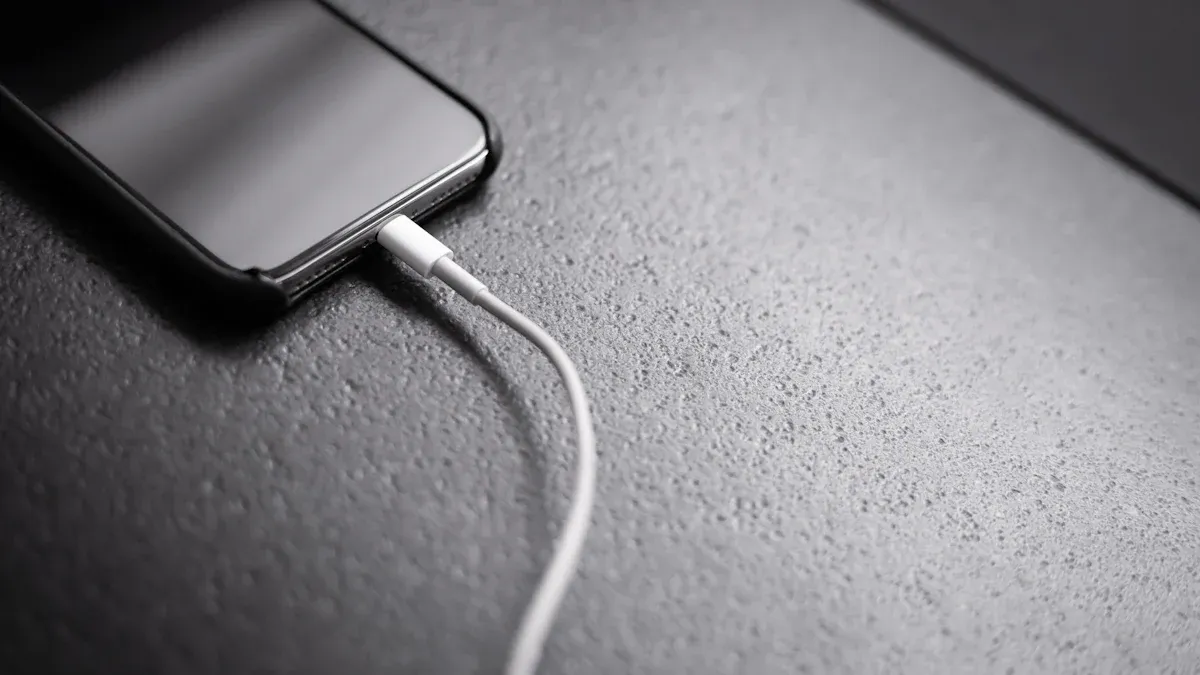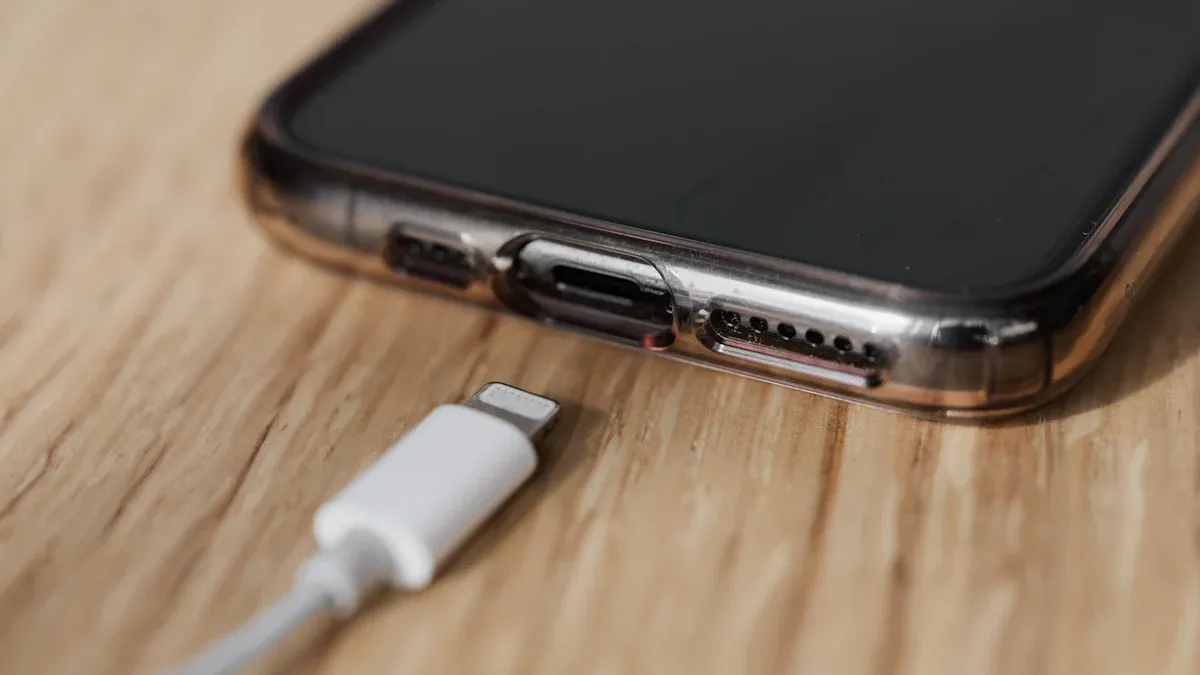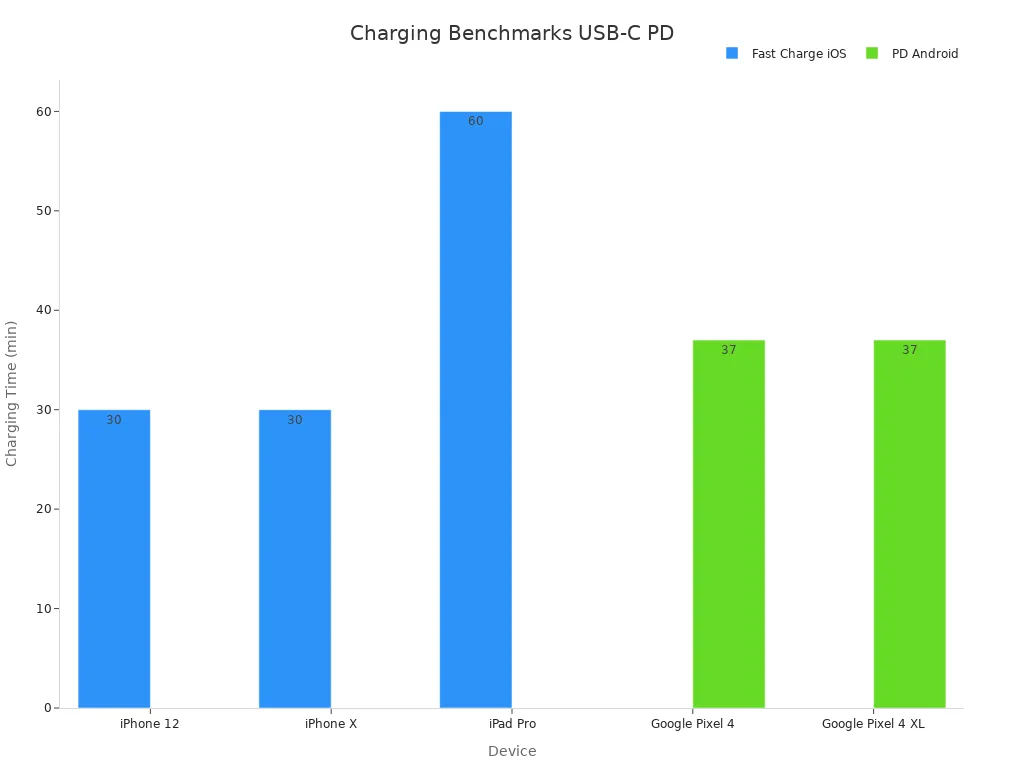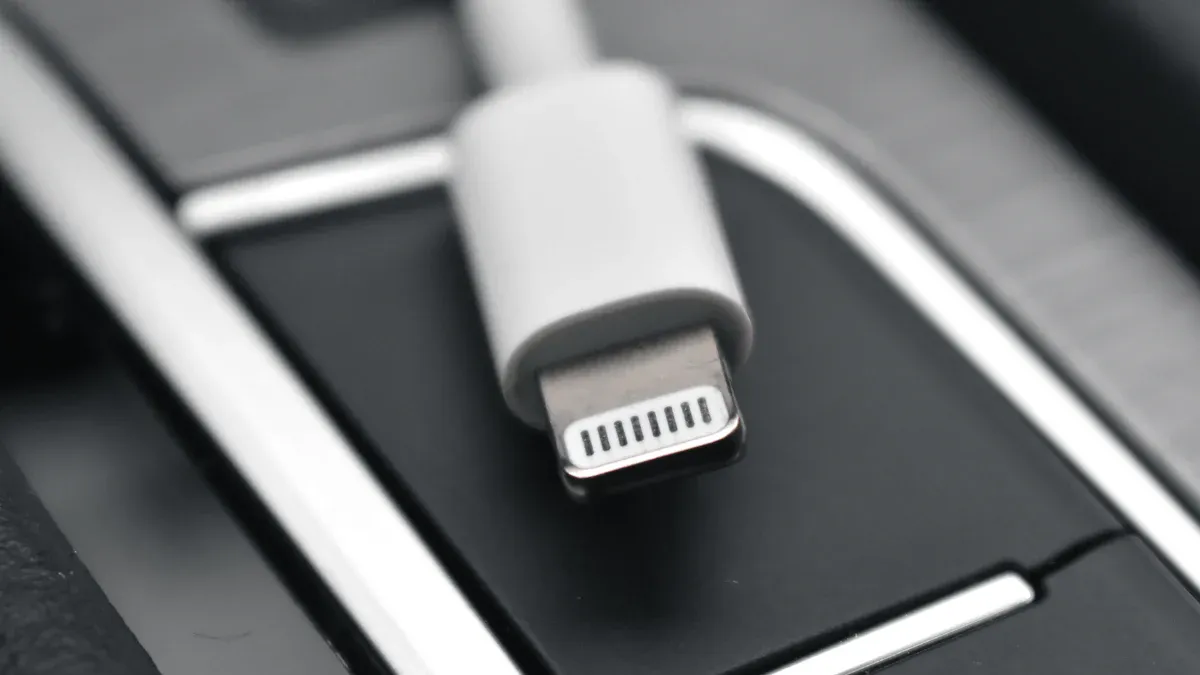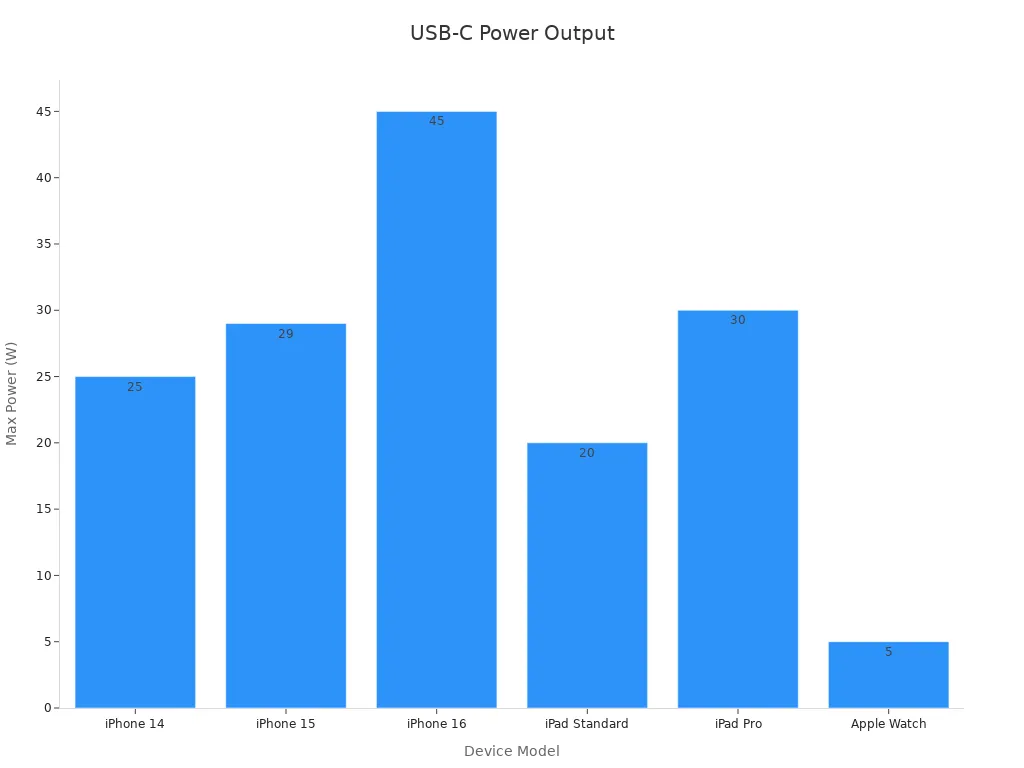Tired of waiting hours for your iPhone to charge? USB-C iPhone chargers are here to change that. With a 20W USB-C charger, you can power your iPhone 14 to 60% in just 30 minutes. Compare that to the sluggish 5W charger, which only hits 20%. Your charging experience will never be the same.
Why USB-C iPhone Chargers Are the Best for Fast Charging
Faster Charging Speeds with USB-C Power Delivery
If you’re tired of waiting for your iPhone to charge, USB-C power delivery is the game-changer you’ve been waiting for. This technology delivers higher wattage, which means your device charges faster than ever. For example, with a USB-C charger rated at 18W or higher, you can charge an iPhone 12 or iPhone X to 50% in just 30 minutes. Compare that to older chargers, and the difference is night and day.
Here’s a quick look at how USB-C power delivery stacks up against other charging methods:
| Charging method | Device | Cable | Charging time (up to 50%) | Charger rated power |
|---|---|---|---|---|
| Fast Charge for iOS | iPhone 12 | Lightning/USB-C | 30 minutes | 18 W or higher |
| Fast Charge for iOS | iPhone X | Lightning/USB-C | 30 minutes | 18 W or higher |
| Fast Charge for iOS | iPad Pro | Lightning/USB-C | 60 minutes | 27 W or higher |
| PD for Android | Google Pixel 4 | USB-C/USB-C | 37 minutes | 18 W or higher |
| PD for Android | Google Pixel 4 XL | USB-C/USB-C | 37 minutes | 18 W or higher |
With USB-C, you’re not just charging faster—you’re saving time and staying connected when it matters most.
Optimized Charging for iPhone Models
USB-C chargers don’t just charge fast; they charge smart. Apple has introduced features like Optimized Charging to protect your battery’s health. For instance, the iPhone 15 series limits charging to 80% when needed, reducing battery wear over time. This means your phone stays in great shape for longer.
Here’s why USB-C chargers are perfect for iPhones:
– They deliver faster charging speeds, especially for models like the iPhone 12 and later.
– They include smart features like Optimized Charging, which prevents overcharging.
– USB-C cables and ports are more durable than older Lightning ones, so you won’t have to replace them as often.
By switching to a USB-C charger, you’re not just upgrading your charging speed—you’re also investing in your iPhone’s long-term performance.
Reduced Charging Time Compared to Lightning Cables
Lightning cables have served their purpose, but they can’t compete with the speed and efficiency of USB-C chargers. USB-C supports up to 240W of power delivery, while Lightning maxes out at around 20W. That’s a massive difference!
Here’s what this means for you:
– You’ll spend less time waiting for your phone to charge.
– USB-C chargers are powerful enough to handle not just your iPhone but also other devices like iPads and MacBooks.
– You’ll enjoy a seamless charging experience, whether you’re at home, at work, or on the go.
Fast charging with USB-C isn’t just about speed—it’s about convenience. With a USB-C charger, you can power up your devices quickly and get back to what matters most.
Key Benefits of Fast iPhone Chargers
Universal Compatibility Across Apple and Non-Apple Devices
One of the best things about USB-C iPhone chargers is their universal compatibility. You can use them with a wide range of devices, not just your iPhone. Whether you’re charging your iPad, MacBook, or even a non-Apple device like a Google Pixel, a USB-C charger gets the job done.
Here’s why this matters:
– You don’t need separate chargers for every device. A single USB-C charger can handle them all.
– USB-C cables meet strict specifications, ensuring they work seamlessly across brands.
– Fast charge technology works with both Apple and non-Apple devices, so you’re always covered.
In product testing, USB-C chargers proved their versatility. They delivered consistent charging speeds and data transfer rates across various devices. For example, testers used a USB-C cable with a MacBook Pro and a USB4 enclosure to measure performance. The results showed that USB-C chargers live up to their promise of universal compatibility.
Compact, Reversible, and Durable Design
USB-C chargers are designed with convenience in mind. They’re compact, easy to use, and built to last. The reversible connector is a game-changer. You’ll never have to fumble around trying to figure out which way to plug it in.
Here’s what makes the design stand out:
– Compact size: Perfect for travel, with some models even featuring foldable plugs.
– Reversible connector: Plug it in any way you like—it always fits.
– Durability: Built with safety features like voltage protection and overheating safeguards.
| Characteristic | Description |
|---|---|
| Compact Design | Small and portable, ideal for on-the-go use. |
| Reversible | No more guessing which side is up—just plug it in. |
| Durable | Includes safety measures to protect against voltage spikes and overheating. |
The USB-C cable itself is a marvel of engineering. It uses a 24-pin system that’s not only compact but also powerful. This design ensures your charger lasts longer and performs better than older models.
Enhanced Longevity for Cables and Adapters
Tired of replacing frayed cables? USB-C chargers are built to last. They’re made with high-quality materials that can withstand daily wear and tear. Plus, they meet USB Power Delivery standards, which means they’re designed for fast charging without compromising durability.
Here’s what you’ll love about USB-C cables and adapters:
– They’re stronger and more reliable than older Lightning cables.
– Continuous improvements in fast-charging technology ensure they stay up-to-date.
– High-quality materials give them a longer lifespan, saving you money in the long run.
Market research shows that consumers are demanding more durable cables. Manufacturers are responding by creating USB-C chargers that not only charge faster but also last longer. This focus on quality means you can trust your USB-C charger to keep up with your busy lifestyle.
Tip: Invest in a certified USB-C charger to get the most out of your fast charging experience. Certified chargers meet strict quality standards, ensuring safety and performance.
How USB-C Power Adapters Future-Proof Your Charging Setup
Compatibility with Newer iPhone Models
Switching to a USB-C charger ensures you’re ready for the latest iPhone models. Apple has already embraced USB-C ports in its newer devices, like the iPhone 15 series. This shift means you no longer need to juggle multiple cables for different devices. A single USB-C cable can handle your iPhone, iPad, and even your MacBook.
The move to USB-C isn’t just about convenience. It’s about staying ahead of the curve. By adopting this technology now, you’re preparing for a future where USB-C becomes the universal standard. Plus, USB-C chargers are designed to support fast charge capabilities, so you’ll always get the best performance from your devices.
Cross-Device Usability (MacBooks, iPads, and More)
Imagine using one charger for all your gadgets. With USB-C, that’s not just a dream—it’s reality. Whether you’re powering up your iPhone, MacBook, or even a non-Apple device like a Google Pixel, USB-C chargers deliver consistent performance.
This cross-device compatibility simplifies your life. No more cluttered drawers filled with different chargers. Just grab your USB-C charger, and you’re good to go. The growing reliance on USB-powered devices, from laptops to IoT gadgets, makes USB-C the perfect solution for a streamlined charging setup.
Tip: Invest in a high-quality USB-C charger to maximize its versatility and durability.
USB-C as the Industry Standard for the Future
USB-C isn’t just a trend—it’s the future. Organizations like the European Commission are pushing for a single charging standard, and USB-C is leading the charge. By 2024, all mobile phones, tablets, and cameras sold in the EU will require USB-C ports. Laptops will follow suit by 2026.
The numbers don’t lie. The global USB-C market is booming, with projections showing massive growth in the coming years. USB-C chargers are becoming the default choice for manufacturers, thanks to their fast charge capabilities and universal compatibility. As technology evolves, USB-C will continue to improve, offering faster speeds and even wireless charging options.
By adopting USB-C now, you’re not just keeping up—you’re staying ahead.
Tips for Choosing the Right USB-C Charger
Look for Certified USB-C Power Adapters
When choosing a USB-C power adapter, certification is key. Certified adapters meet strict safety and performance standards, ensuring your devices charge efficiently and safely. Look for certifications like USB-IF Product Certification Testing, which guarantees compliance with USB specifications.
Here’s a quick guide to important certifications:
| Certification Standard | Description |
|---|---|
| USB-IF Product Certification Testing | Ensures reliable data transmission and power delivery. |
| USB Type-C Power Banks Certification | Verifies port capabilities and proper labeling for power banks. |
| Certified Connectors Required | Mandates the use of certified connectors for USB Type-C products. |
| Billboard Requirement for Insufficient Power | Alerts users when devices aren’t receiving enough power. |
Certified adapters not only protect your devices but also deliver consistent performance. Always check for official logos or labels on the packaging before purchasing.
Match Power Output to Your iPhone Model
Not all iPhones require the same power output. Using the right charger ensures optimal charging speed without risking your battery’s health. For example, the iPhone 15 supports up to 29W, while the iPhone 16 can handle 45W.
Here’s a breakdown of power requirements for popular Apple devices:
| Device Model | Maximum Power Output |
|---|---|
| iPhone 14 | 25W |
| iPhone 15 | 29W |
| iPhone 16 | 45W |
| iPad Standard | 20W |
| iPad Pro | 30W |
| Apple Watch | 5W |
If you plan to charge multiple devices, consider a higher-wattage adapter. For instance, a 100W charger can handle an iPhone 16 and a MacBook Pro sequentially.
Select Durable and Reliable USB-C Cables
A high-quality USB-C cable is just as important as the adapter. Look for cables with certifications like USB-IF or Thunderbolt, which ensure durability and performance. Reliable cables often include features like E-Marker chips for handling higher currents.
Here are some tips for spotting durable cables:
– Check for official logos on the packaging.
– Avoid cables made from low-grade materials.
– Ensure cables over 3A have an E-Marker chip.
In durability tests, the Amazon Basics USB-C cable stood out. It lasted the equivalent of six years under bending stress, proving its reliability. Investing in a durable charging cable saves you money and ensures a hassle-free charging experience.
Avoid Unverified or Low-Quality Chargers
Unverified chargers might seem like a bargain, but they can damage your devices. Poorly designed chargers often lack safety features, leading to overheating or voltage spikes. Stick to trusted brands and certified products to avoid these risks.
Here’s why you should avoid low-quality chargers:
– They may not meet USB-PD standards, resulting in slower charging.
– Subpar materials can cause the charger to fail prematurely.
– They often lack safeguards against power surges.
Tip: Always read reviews and check for certifications before buying a charger. A little research goes a long way in protecting your devices.
Addressing Common Concerns About USB-C iPhone Chargers
Are USB-C Chargers Safe for iPhones?
You might wonder if USB-C chargers are safe for your iPhone. The short answer is yes—when you choose certified chargers. Manufacturers put USB-C chargers through rigorous testing to ensure they meet safety standards. For example, over 239 tests are conducted to check for issues like overheating and overcharging. These chargers also go through an 18-month design process to ensure they’re reliable and user-friendly.
However, not all chargers are created equal. Generic or unverified chargers can pose risks. A study by Electrical Safety First found that 58% of generic chargers failed electric strength tests, increasing the chances of overheating or electric shock. To stay safe, always use manufacturer-approved chargers or those certified by trusted labs like UL Solutions.
Tip: Look for chargers with safety certifications and avoid cheap, unverified options. Your iPhone—and your safety—are worth it.
What About Older iPhones Without USB-C Ports?
If you’re using an older iPhone with a Lightning port, you might think USB-C chargers aren’t for you. But here’s the good news: they can still work! You’ll just need a USB-C to Lightning cable. This allows you to enjoy the benefits of fast chargers, even with older models.
Older chargers can also work with newer iPhones, but they may not deliver the same speed. That’s because iPhones are designed to draw only the power they need, ensuring safety and efficiency. While transitioning to USB-C might seem like a hassle, it’s a step toward a universal standard that simplifies charging for all devices.
Can USB-C Chargers Be Used with Non-Apple Devices?
Absolutely! USB-C chargers are designed for universal compatibility. Whether you’re charging a MacBook, an iPad, or even a non-Apple device like a Google Pixel, a USB-C cable gets the job done. Just keep in mind that charging speeds might vary depending on the device.
USB-C’s compliance with EU regulations ensures it works safely across different brands. This makes it a versatile choice for anyone looking to streamline their charging setup. With USB-C becoming the industry standard, you can expect even greater compatibility in the future.
Note: Investing in a high-quality USB-C charger ensures you’re ready for all your devices, now and in the years to come.
USB-C iPhone chargers are a game-changer. They offer faster charging, universal compatibility, and future-proof technology. With speeds up to 40Gbps and power delivery reaching 100W, they outperform Lightning cables in every way. Plus, their versatility lets you use one cable for multiple devices. It’s time to embrace this revolutionary upgrade!
| Feature | USB-C Capability |
|---|---|
| Power Delivery | Supports higher wattage for faster charging. |
| Data Transfer Speed | Up to 40Gbps, a major improvement over previous standards. |
| Protocol Versatility | Supports various protocols, allowing for multiple connection types. |
Note: Transitioning to USB-C simplifies your life and ensures you’re ready for the future of charging.
FAQ
1. Can I use my old Lightning cables with a USB-C adapter?
Yes, you can! Just pair your Lightning cable with a USB-C to Lightning adapter. It’s a simple way to keep using your existing cables.
2. Do USB-C chargers work with wireless charging pads?
Absolutely! USB-C chargers power most wireless charging pads. Just connect the pad to the USB-C adapter, and you’re good to go.
3. How do I know if my USB-C charger is certified?
Look for certifications like USB-IF or Apple MFi on the packaging. These labels ensure the charger meets safety and performance standards.
Tip: Always double-check for official logos to avoid counterfeit products. Certified chargers protect your devices and deliver consistent performance.

